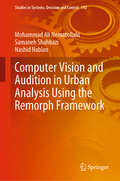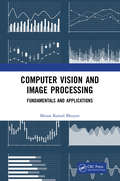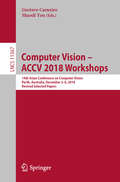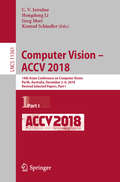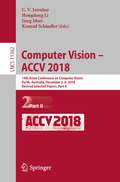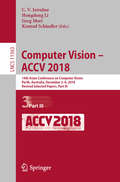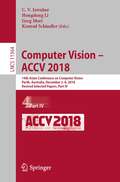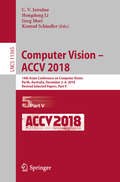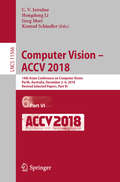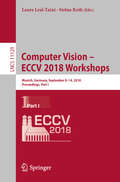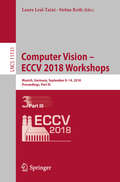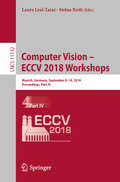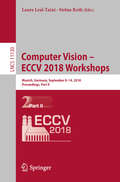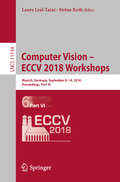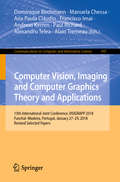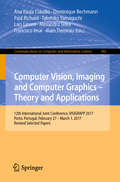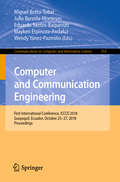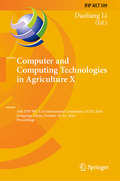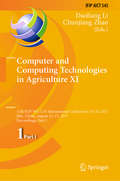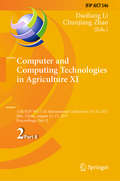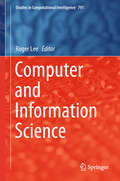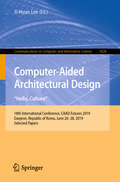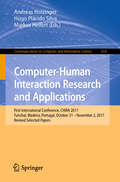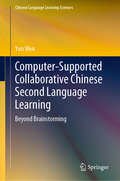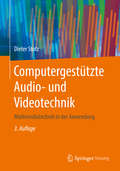- Table View
- List View
Computer Vision and Audition in Urban Analysis Using the Remorph Framework (Studies in Systems, Decision and Control #192)
by Mohammad Ali Nematollahi Samaneh Shahbazi Nashid NabianArtificial Intelligence (AI) is penetrating in all sciences as a multidisciplinary approach. However, adopting the theory of AI including computer vision and computer audition to urban intellectual space, is always difficult for architecture and urban planners. This book overcomes this challenge through a conceptual framework by merging computer vision and audition to urban studies based on a series of workshops called Remorph, conducted by Tehran Urban Innovation Center (TUIC).
Computer Vision and Image Processing: Fundamentals and Applications
by Manas Kamal BhuyanThe book familiarizes readers with fundamental concepts and issues related to computer vision and major approaches that address them. The focus of the book is on image acquisition and image formation models, radiometric models of image formation, image formation in the camera, image processing concepts, concept of feature extraction and feature selection for pattern classification/recognition, and advanced concepts like object classification, object tracking, image-based rendering, and image registration. Intended to be a companion to a typical teaching course on computer vision, the book takes a problem-solving approach.
Computer Vision – ACCV 2018 Workshops: 14th Asian Conference on Computer Vision, Perth, Australia, December 2–6, 2018, Revised Selected Papers (Lecture Notes in Computer Science #11367)
by Gustavo Carneiro Shaodi YouThis LNCS workshop proceedings, ACCV 2018, contains carefully reviewed and selected papers from 11 workshops, each having different types or programs: Scene Understanding and Modelling (SUMO) Challenge, Learning and Inference Methods for High Performance Imaging (LIMHPI), Attention/Intention Understanding (AIU), Museum Exhibit Identification Challenge (Open MIC) for Domain Adaptation and Few-Shot Learning, RGB-D - Sensing and Understanding via Combined Colour and Depth, Dense 3D Reconstruction for Dynamic Scenes, AI Aesthetics in Art and Media (AIAM), Robust Reading (IWRR), Artificial Intelligence for Retinal Image Analysis (AIRIA), Combining Vision and Language, Advanced Machine Vision for Real-life and Industrially Relevant Applications (AMV).
Computer Vision – ACCV 2018: 14th Asian Conference on Computer Vision, Perth, Australia, December 2–6, 2018, Revised Selected Papers, Part I (Lecture Notes in Computer Science #11361)
by C. V. Jawahar Hongdong Li Greg Mori Konrad SchindlerThe six volume set LNCS 11361-11366 constitutes the proceedings of the 14th Asian Conference on Computer Vision, ACCV 2018, held in Perth, Australia, in December 2018. The total of 274 contributions was carefully reviewed and selected from 979 submissions during two rounds of reviewing and improvement. The papers focus on motion and tracking, segmentation and grouping, image-based modeling, dep learning, object recognition object recognition, object detection and categorization, vision and language, video analysis and event recognition, face and gesture analysis, statistical methods and learning, performance evaluation, medical image analysis, document analysis, optimization methods, RGBD and depth camera processing, robotic vision, applications of computer vision.
Computer Vision – ACCV 2018: 14th Asian Conference on Computer Vision, Perth, Australia, December 2–6, 2018, Revised Selected Papers, Part II (Lecture Notes in Computer Science #11362)
by C. V. Jawahar Hongdong Li Greg Mori Konrad SchindlerThe six volume set LNCS 11361-11366 constitutes the proceedings of the 14th Asian Conference on Computer Vision, ACCV 2018, held in Perth, Australia, in December 2018. The total of 274 contributions was carefully reviewed and selected from 979 submissions during two rounds of reviewing and improvement. The papers focus on motion and tracking, segmentation and grouping, image-based modeling, dep learning, object recognition object recognition, object detection and categorization, vision and language, video analysis and event recognition, face and gesture analysis, statistical methods and learning, performance evaluation, medical image analysis, document analysis, optimization methods, RGBD and depth camera processing, robotic vision, applications of computer vision.
Computer Vision – ACCV 2018: 14th Asian Conference on Computer Vision, Perth, Australia, December 2–6, 2018, Revised Selected Papers, Part III (Lecture Notes in Computer Science #11363)
by C. V. Jawahar Hongdong Li Greg Mori Konrad SchindlerThe six volume set LNCS 11361-11366 constitutes the proceedings of the 14th Asian Conference on Computer Vision, ACCV 2018, held in Perth, Australia, in December 2018. The total of 274 contributions was carefully reviewed and selected from 979 submissions during two rounds of reviewing and improvement. The papers focus on motion and tracking, segmentation and grouping, image-based modeling, dep learning, object recognition object recognition, object detection and categorization, vision and language, video analysis and event recognition, face and gesture analysis, statistical methods and learning, performance evaluation, medical image analysis, document analysis, optimization methods, RGBD and depth camera processing, robotic vision, applications of computer vision.
Computer Vision – ACCV 2018: 14th Asian Conference on Computer Vision, Perth, Australia, December 2–6, 2018, Revised Selected Papers, Part IV (Lecture Notes in Computer Science #11364)
by C. V. Jawahar Hongdong Li Greg Mori Konrad SchindlerThe six volume set LNCS 11361-11366 constitutes the proceedings of the 14th Asian Conference on Computer Vision, ACCV 2018, held in Perth, Australia, in December 2018. The total of 274 contributions was carefully reviewed and selected from 979 submissions during two rounds of reviewing and improvement. The papers focus on motion and tracking, segmentation and grouping, image-based modeling, dep learning, object recognition object recognition, object detection and categorization, vision and language, video analysis and event recognition, face and gesture analysis, statistical methods and learning, performance evaluation, medical image analysis, document analysis, optimization methods, RGBD and depth camera processing, robotic vision, applications of computer vision.
Computer Vision – ACCV 2018: 14th Asian Conference on Computer Vision, Perth, Australia, December 2–6, 2018, Revised Selected Papers, Part V (Lecture Notes in Computer Science #11365)
by C. V. Jawahar Hongdong Li Greg Mori Konrad SchindlerThe six volume set LNCS 11361-11366 constitutes the proceedings of the 14th Asian Conference on Computer Vision, ACCV 2018, held in Perth, Australia, in December 2018. The total of 274 contributions was carefully reviewed and selected from 979 submissions during two rounds of reviewing and improvement. The papers focus on motion and tracking, segmentation and grouping, image-based modeling, dep learning, object recognition object recognition, object detection and categorization, vision and language, video analysis and event recognition, face and gesture analysis, statistical methods and learning, performance evaluation, medical image analysis, document analysis, optimization methods, RGBD and depth camera processing, robotic vision, applications of computer vision.
Computer Vision – ACCV 2018: 14th Asian Conference on Computer Vision, Perth, Australia, December 2–6, 2018, Revised Selected Papers, Part VI (Lecture Notes in Computer Science #11366)
by C. V. Jawahar Hongdong Li Greg Mori Konrad SchindlerThe six volume set LNCS 11361-11366 constitutes the proceedings of the 14th Asian Conference on Computer Vision, ACCV 2018, held in Perth, Australia, in December 2018. The total of 274 contributions was carefully reviewed and selected from 979 submissions during two rounds of reviewing and improvement. The papers focus on motion and tracking, segmentation and grouping, image-based modeling, dep learning, object recognition object recognition, object detection and categorization, vision and language, video analysis and event recognition, face and gesture analysis, statistical methods and learning, performance evaluation, medical image analysis, document analysis, optimization methods, RGBD and depth camera processing, robotic vision, applications of computer vision.
Computer Vision – ECCV 2018 Workshops: Munich, Germany, September 8-14, 2018, Proceedings, Part I (Lecture Notes in Computer Science #11129)
by Stefan Roth Laura Leal-TaixéThe six-volume set comprising the LNCS volumes 11129-11134 constitutes the refereed proceedings of the workshops that took place in conjunction with the 15th European Conference on Computer Vision, ECCV 2018, held in Munich, Germany, in September 2018.43 workshops from 74 workshops proposals were selected for inclusion in the proceedings. The workshop topics present a good orchestration of new trends and traditional issues, built bridges into neighboring fields, and discuss fundamental technologies and novel applications.
Computer Vision – ECCV 2018 Workshops: Munich, Germany, September 8-14, 2018, Proceedings, Part I (Lecture Notes in Computer Science #11129)
by Stefan Roth Laura Leal-TaixéThe six-volume set comprising the LNCS volumes 11129-11134 constitutes the refereed proceedings of the workshops that took place in conjunction with the 15th European Conference on Computer Vision, ECCV 2018, held in Munich, Germany, in September 2018.43 workshops from 74 workshops proposals were selected for inclusion in the proceedings. The workshop topics present a good orchestration of new trends and traditional issues, built bridges into neighboring fields, and discuss fundamental technologies and novel applications.
Computer Vision – ECCV 2018 Workshops: Munich, Germany, September 8-14, 2018, Proceedings, Part I (Lecture Notes in Computer Science #11129)
by Stefan Roth Laura Leal-TaixéThe six-volume set comprising the LNCS volumes 11129-11134 constitutes the refereed proceedings of the workshops that took place in conjunction with the 15th European Conference on Computer Vision, ECCV 2018, held in Munich, Germany, in September 2018.43 workshops from 74 workshops proposals were selected for inclusion in the proceedings. The workshop topics present a good orchestration of new trends and traditional issues, built bridges into neighboring fields, and discuss fundamental technologies and novel applications.
Computer Vision – ECCV 2018 Workshops: Munich, Germany, September 8-14, 2018, Proceedings, Part II (Lecture Notes in Computer Science #11130)
by Stefan Roth Laura Leal-TaixéThe six-volume set comprising the LNCS volumes 11129-11134 constitutes the refereed proceedings of the workshops that took place in conjunction with the 15th European Conference on Computer Vision, ECCV 2018, held in Munich, Germany, in September 2018. 43 workshops from 74 workshops proposals were selected for inclusion in the proceedings. The workshop topics present a good orchestration of new trends and traditional issues, built bridges into neighboring fields, and discuss fundamental technologies and novel applications.
Computer Vision – ECCV 2018 Workshops: Munich, Germany, September 8-14, 2018, Proceedings, Part VI (Lecture Notes in Computer Science #11134)
by Stefan Roth Laura Leal-TaixéThe six-volume set comprising the LNCS volumes 11129-11134 constitutes the refereed proceedings of the workshops that took place in conjunction with the 15th European Conference on Computer Vision, ECCV 2018, held in Munich, Germany, in September 2018.43 workshops from 74 workshops proposals were selected for inclusion in the proceedings. The workshop topics present a good orchestration of new trends and traditional issues, built bridges into neighboring fields, and discuss fundamental technologies and novel applications.
Computer Vision, Imaging and Computer Graphics Theory and Applications: 13th International Joint Conference, VISIGRAPP 2018 Funchal–Madeira, Portugal, January 27–29, 2018, Revised Selected Papers (Communications in Computer and Information Science #997)
by Andreas Kerren Paul Richard Francisco Imai Alexandru Telea Ana Paula Cláudio Dominique Bechmann Alain Tremeau Manuela ChessaThis book constitutes thoroughly revised and selected papers from the 13th International Joint Conference on Computer Vision, Imaging and Computer Graphics Theory and Applications, VISIGRAPP 2018, held in Funchal-Madeira, Portugal, in January 2018. The 18 thoroughly revised and extended papers presented in this volume were carefully reviewed and selected from 317 submissions. The papers contribute to the understanding of relevant trends of current research on computer graphics; human computer interaction; information visualization; computer vision.
Computer Vision, Imaging and Computer Graphics – Theory and Applications: 12th International Joint Conference, VISIGRAPP 2017, Porto, Portugal, February 27 – March 1, 2017, Revised Selected Papers (Communications in Computer and Information Science #983)
by Lars Linsen Paul Richard Francisco Imai Alexandru Telea Ana Paula Cláudio Dominique Bechmann Takehiko Yamaguchi Alain TremeauThis book constitutes thoroughly revised and selected papers from the 12th International Joint Conference on Computer Vision, Imaging and Computer Graphics Theory and Applications, VISIGRAPP 2017, held in Porto, Portugal, February 27 - March 1, 2017. The 18 thoroughly revised and extended papers presented in this volume were carefully reviewed and selected from 402 submissions. The papers contribute to the understanding of relevant trends of current research on image and video formation, preprocessing, analysis and understanding; motion, tracking and stereo vision; computer graphics and rendering; data visualization and interactive visual data analysis; agent-based human-robot interactions; and user experience.
Computer and Communication Engineering: First International Conference, ICCCE 2018, Guayaquil, Ecuador, October 25–27, 2018, Proceedings (Communications in Computer and Information Science #959)
by Miguel Botto-Tobar Julio Barzola-Monteses Eduardo Santos-Baquerizo Mayken Espinoza-Andaluz Wendy Yánez-PazmiñoThis book constitutes the proceedings of the First International Conference on Computer and Communication Engineering, ICCCE 2018, held in Guayaquil, Ecuador, in October 2018. The 12 full papers presented were carefully reviewed and selected from 68 submissions. The papers deal with topics such as networking protocols and performance; software engineering; information systems; and computational intelligence. They are organized in the following topical headings: communications; and computer and software engineering.
Computer and Computing Technologies in Agriculture X: 10th IFIP WG 5.14 International Conference, CCTA 2016, Dongying, China, October 19–21, 2016, Proceedings (IFIP Advances in Information and Communication Technology #509)
by Daoliang LiThis book constitutes the refereed post-conference proceedings of the 10th IFIP WG 5.14 International Conference on Computer and Computing Technologies in Agriculture, CCTA 2016, held in Dongying, China, in October 2016. The 55 revised papers presented were carefully reviewed and selected from 128 submissions. They cover a wide range of interesting theories and applications of information technology in agriculture, including intelligent sensing, cloud computing, key technologies of the Internet of Things, precision agriculture, animal husbandry information technology, including Internet + modern animal husbandry, livestock big data platform and cloud computing applications, intelligent breeding equipment, precision production models, water product networking and big data , including fishery IoT, intelligent aquaculture facilities, and big data applications.
Computer and Computing Technologies in Agriculture XI (IFIP Advances in Information and Communication Technology #545)
by Daoliang Li Chunjiang ZhaoThe two volumes IFIP AICT 545 and 546 constitute the refereed post-conference proceedings of the 11th IFIP WG 5.14 International Conference on Computer and Computing Technologies in Agriculture, CCTA 2017, held in Jilin, China, in August 2017. The 100 revised papers included in the two volumes were carefully reviewed and selected from 282 submissions. They cover a wide range of interesting theories and applications of information technology in agriculture. The papers focus on four topics: Internet of Things and big data in agriculture, precision agriculture and agricultural robots, agricultural information services, and animal and plant phenotyping for agriculture.
Computer and Computing Technologies in Agriculture XI: 11th IFIP WG 5.14 International Conference, CCTA 2017, Jilin, China, August 12-15, 2017, Proceedings, Part II (IFIP Advances in Information and Communication Technology #546)
by Daoliang Li Chunjiang ZhaoThe two volumes IFIP AICT 545 and 546 constitute the refereed post-conference proceedings of the 11th IFIP WG 5.14 International Conference on Computer and Computing Technologies in Agriculture, CCTA 2017, held in Jilin, China, in August 2017.The 100 revised papers included in the two volumes were carefully reviewed and selected from 282 submissions. They cover a wide range of interesting theories and applications of information technology in agriculture. The papers focus on four topics: Internet of Things and big data in agriculture, precision agriculture and agricultural robots, agricultural information services, and animal and plant phenotyping for agriculture.
Computer and Information Science (Studies in Computational Intelligence #791)
by Roger LeeThis book presents the outcomes of the 17th IEEE/ACIS International Conference on Computer and Information Science (ICIS 2018), which was held in Singapore on June 6–8, 2018. The aim of the conference was to bring together researchers and scientists, businessmen and entrepreneurs, teachers, engineers, computer users, and students to discuss the various fields of computer science and to share their experiences, and to exchange new ideas and information in a meaningful way. The book includes findings on all aspects (theory, applications and tools) of computer and information science and discusses related practical challenges and the solutions adopted to solve them. The conference organizers selected the best papers from those accepted for presentation. The papers were chosen based on review scores submitted by members of the program committee and underwent a further rigorous round of review. From this second round, 13 of the conference’s most promising papers were then published in this Springer (SCI) book and not the conference proceedings. We impatiently await the important contributions that we know these authors will make to the field of computer and information science.
Computer-Aided Architectural Design. "Hello, Culture": 18th International Conference, CAAD Futures 2019, Daejeon, Republic of Korea, June 26–28, 2019, Selected Papers (Communications in Computer and Information Science #1028)
by Ji-Hyun LeeThis book constitutes selected papers of the 18th International Conference on Computer-Aided Architectural Design Futures, CAAD Futures 2019, held in Daejeon, Republic of Korea, in June 2019. The 34 revised full papers presented were carefully reviewed and selected from 194 submissions. The papers are organized in topical sections on theory, methodology and practice of architectural and interior design; support systems for design decisions; tools, methods and implementation of urban design; rethinking space and spatial behavior; fabrication and materialization; and shape studies.
Computer-Human Interaction Research and Applications: First International Conference, CHIRA 2017, Funchal, Madeira, Portugal, October 31 – November 2, 2017, Revised Selected Papers (Communications in Computer and Information Science #654)
by Andreas Holzinger Markus Helfert Hugo Plácido SilvaThis book constitutes the refereed proceedings of the First International Conference on Computer-Human Interaction Research and Applications, CHIRA 2017, held in Funchal, Madeira, Portugal, in October/November 2017.The 8 full papers presented in this book were carefully reviewed and selected from 35 submissions. The papers selected to be included in this book contribute to the understanding of relevant trends of current research on computer-human interaction, including Interaction design, human factors, entertainment, cognition, perception, user-friendly software and systems, pervasive technologies and interactive devices.
Computer-Supported Collaborative Chinese Second Language Learning: Beyond Brainstorming (Chinese Language Learning Sciences)
by Yun WenThis book explores the implementation of an online representational tool, GroupScribbles, in Chinese-as-a-second-language classrooms from primary school to secondary school. It demonstrates the effectiveness of combining online representational tools with face-to-face classroom learning, and provides a workable approach to analysing interactions interweaving social and cognitive dimensions, which take place in the networked classroom. A series of suggestions regarding networked second language learning will help educators effectively implement information and communication technology tools in the classroom.
Computergestützte Audio- und Videotechnik: Multimediatechnik in der Anwendung
by Dieter StotzDiese Einführung in die moderne Audio- und Videotechnik ermöglicht Lesern mit technischem Grundverständnis einen leichten Einstieg – auch in komplexe Zusammenhänge. Der Autor vermittelt detailliertes Wissen, praxisnah und verständlich aufbereitet: von den Grundlagen der Ton- und Videotechnik über Abtastung und Digitalisierung, räumliches Hören, Datenkompression, MIDI-Standard und -Signale, digitale Audiomesstechnik bis zu hochauflösender Videotechnik, Genlock, Chromakeying, Schnittsystemen und Animation. Mit vielen Graphiken und Abbildungen.
